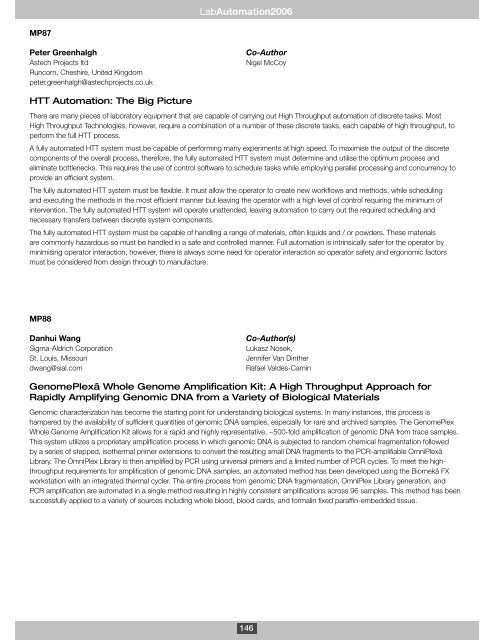LabAutomation 2006 - SLAS
LabAutomation 2006 - SLAS
LabAutomation 2006 - SLAS
You also want an ePaper? Increase the reach of your titles
YUMPU automatically turns print PDFs into web optimized ePapers that Google loves.
MP87<br />
Peter Greenhalgh<br />
Astech Projects ltd<br />
Runcorn, Cheshire, United Kingdom<br />
peter.greenhalgh@astechprojects.co.uk<br />
HTT Automation: The Big Picture<br />
<strong>LabAutomation</strong><strong>2006</strong><br />
Co-Author<br />
Nigel McCoy<br />
There are many pieces of laboratory equipment that are capable of carrying out High Throughput automation of discrete tasks. Most<br />
High Throughput Technologies, however, require a combination of a number of these discrete tasks, each capable of high throughput, to<br />
perform the full HTT process.<br />
A fully automated HTT system must be capable of performing many experiments at high speed. To maximise the output of the discrete<br />
components of the overall process, therefore, the fully automated HTT system must determine and utilise the optimum process and<br />
eliminate bottlenecks. This requires the use of control software to schedule tasks while employing parallel processing and concurrency to<br />
provide an efficient system.<br />
The fully automated HTT system must be flexible. It must allow the operator to create new workflows and methods, while scheduling<br />
and executing the methods in the most efficient manner but leaving the operator with a high level of control requiring the minimum of<br />
intervention. The fully automated HTT system will operate unattended, leaving automation to carry out the required scheduling and<br />
necessary transfers between discrete system components.<br />
The fully automated HTT system must be capable of handling a range of materials, often liquids and / or powders. These materials<br />
are commonly hazardous so must be handled in a safe and controlled manner. Full automation is intrinsically safer for the operator by<br />
minimising operator interaction, however, there is always some need for operator interaction so operator safety and ergonomic factors<br />
must be considered from design through to manufacture.<br />
MP88<br />
Danhui Wang<br />
Sigma-Aldrich Corporation<br />
St. Louis, Missouri<br />
dwang@sial.com<br />
Co-Author(s)<br />
Lukasz Nosek,<br />
Jennifer Van Dinther<br />
Rafael Valdes-Camin<br />
GenomePlexâ Whole Genome Amplification Kit: A High Throughput Approach for<br />
Rapidly Amplifying Genomic DNA from a Variety of Biological Materials<br />
Genomic characterization has become the starting point for understanding biological systems. In many instances, this process is<br />
hampered by the availability of sufficient quantities of genomic DNA samples, especially for rare and archived samples. The GenomePlex<br />
Whole Genome Amplification Kit allows for a rapid and highly representative, ~500-fold amplification of genomic DNA from trace samples.<br />
This system utilizes a proprietary amplification process in which genomic DNA is subjected to random chemical fragmentation followed<br />
by a series of stepped, isothermal primer extensions to convert the resulting small DNA fragments to the PCR-amplifiable OmniPlexâ<br />
Library. The OmniPlex Library is then amplified by PCR using universal primers and a limited number of PCR cycles. To meet the highthroughput<br />
requirements for amplification of genomic DNA samples, an automated method has been developed using the Biomekâ FX<br />
workstation with an integrated thermal cycler. The entire process from genomic DNA fragmentation, OmniPlex Library generation, and<br />
PCR amplification are automated in a single method resulting in highly consistent amplifications across 96 samples. This method has been<br />
successfully applied to a variety of sources including whole blood, blood cards, and formalin fixed paraffin-embedded tissue.<br />
146
















